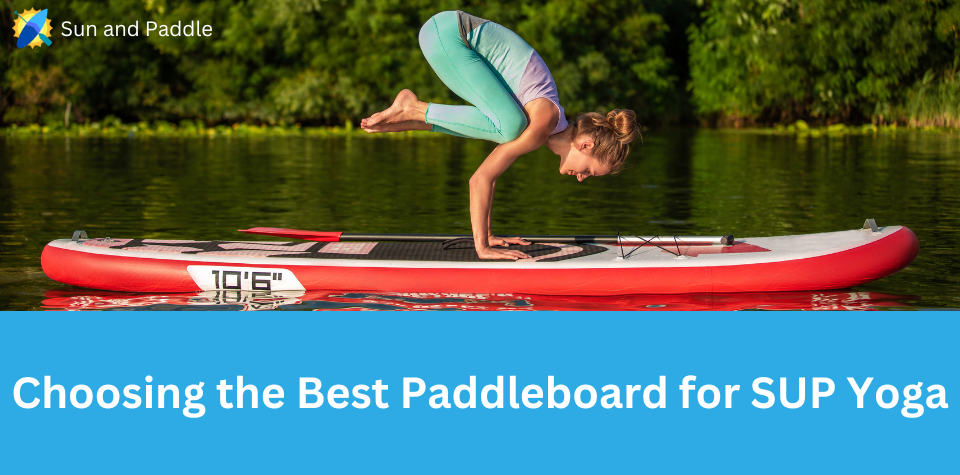How to Choose the Best Paddleboard for SUP Yoga: Key Features and Tips
Stand-up paddleboarding (SUP) yoga is a unique blend of two activities that focuses on enhancing balance, core strength, and mindfulness. Choosing the best paddleboard for SUP yoga involves considering factors like stability, size, and material. Stability is crucial as it affects how well you can perform yoga poses on the water.
Inflatable boards are often recommended because they are lightweight and easy to transport, while solid boards tend to offer a more stable feel. The width and thickness of the board also play a significant role; wider and slightly thinner boards tend to provide better stability than narrower ones.
Durability is another key factor to consider, especially if you plan to use the board frequently. Boards made from high-quality materials will last longer and provide better performance. Weight capacity is also important; make sure the board can support your weight along with any additional gear you might have.
Key Takeaways
- Stability, size, and material are key features for a SUP yoga board.
- Inflatable boards are lightweight and portable; solid boards are more stable.
- Durability and weight capacity should match your usage and needs.
What Are the Most Important Features of a SUP Yoga Board?
Choosing the best SUP yoga board involves considering several key features that directly affect stability, balance, and overall yoga practice. Important aspects include the type of board, its size, the deck pad, and the fin setup.
Type: Inflatable vs Rigid
Inflatable Boards are popular for SUP yoga due to their portability and ease of storage. They usually come with a pump and can be inflated on-site. This makes them easy to transport and store in small spaces. Rigid Boards, on the other hand, are often more stable and may offer a better grip. They can be more durable in the long term but require more storage space and are harder to transport.
Both types can provide stable platforms for yoga, but inflatables might have a slight cushioning effect, which some yogis prefer for added comfort during poses. Durability versus portability is a key trade-off to consider when deciding between inflatable and rigid boards.
The Size

Length
The length of a SUP yoga board can range from about 10 to 12 feet. A board that is 10’6″ to 11′ long usually provides a good balance between stability and maneuverability.
Width
Width is crucial for stability; a width of 32″ to 35″ is ideal because it provides a broader platform, making it easier to maintain balance during yoga poses.
Thickness
Thickness typically ranges between 5″ and 6″. Thicker boards tend to support more weight and provide better buoyancy.
Volume & Weight Capacity
The volume and weight capacity are also important; ensure the board can support your weight along with any gear you bring along.
The Deck Pad of SUP Yoga Boards
A deck pad provides the necessary grip and comfort required for yoga. Look for a deck pad that covers a large portion of the board to allow freedom of movement during your practice. Traction pads with a good grip are crucial to prevent slipping when performing various yoga poses.
Material and texture of the deck pad can affect comfort. Soft, cushioned pads offer comfort during long sessions, while textured surfaces provide better grip. Some boards also offer an additional center handle, which can make carrying the board easier when not in use.
Fin Set Up
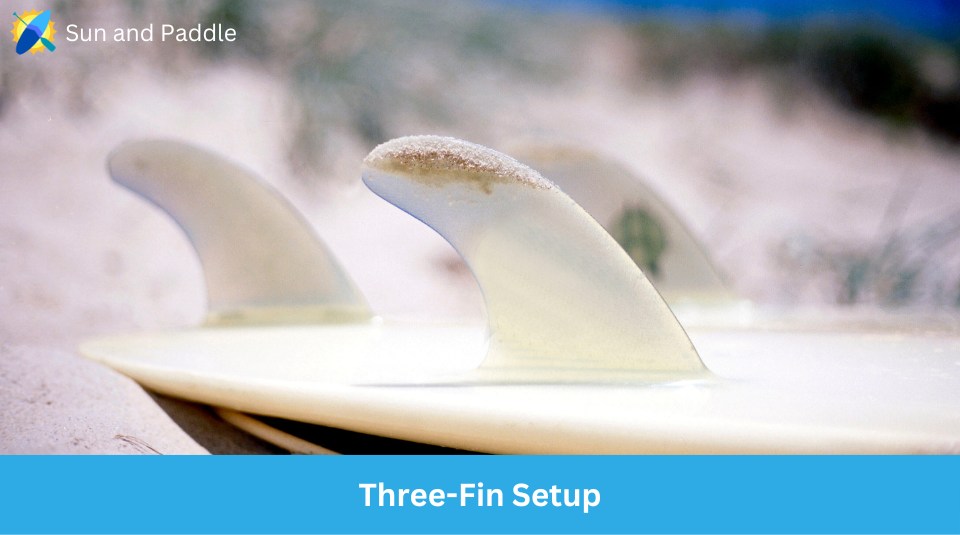
The fin setup can impact the board’s stability and performance on the water. Many SUP yoga boards use a 2+1 fin system, which includes a larger center fin and two smaller side fins. This configuration helps maintain good tracking and stability, crucial for holding yoga poses without wobbling.
Removable fins offer versatility, as they can be taken off when not needed, making transport and storage easier. A well-designed center fin helps in straight-line paddling, while side fins assist in balance and control.
By considering these features carefully, you can choose a SUP yoga board that enhances your practice and provides optimal stability, comfort, and performance on the water.
How to Anchor Your Board
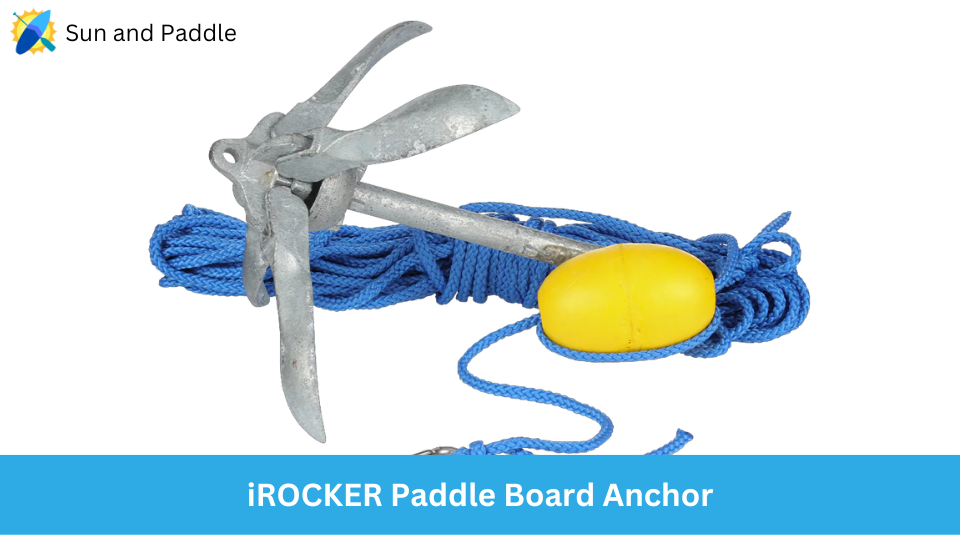
Anchoring is important for doing SUP yoga. An anchor keeps the board steady in the water, letting you focus on your poses.
Key Components
1. Anchor: A grapnel or folding anchor works well. It is lightweight and easy to store. Choose an anchor weighing around 3.5 pounds for stability.
2. Leash: Attach the leash to a D-ring on your board to keep it close while you do yoga.
3. D-rings and Bungee System: These are useful for adding extra gear like a water bottle or dry bag. The bungee system can also hold the anchor line firmly.
Steps to Anchor
- Set Up the Anchor: Place the anchor in its bag along with the rope and float ball.
- Attach the Anchor Line: Secure the anchor line to one of the D-rings on your board.
- Deploy the Anchor: Drop the anchor into the water and let it sink. Make sure the line is long enough to reach the bottom.
- Check Stability: Once the anchor hits the bottom, gently pull on the line to ensure it is secure.
By following these steps and using the right equipment, your board will stay in place, making your SUP yoga session more enjoyable.
Special Considerations
When choosing a paddleboard for SUP yoga, stability is key. A wider board, about 33 to 36 inches, provides a stable platform for various yoga poses. This helps maintain balance when transitioning between movements.
Board thickness also impacts stability. Boards that are 5 inches thick often ride lower on the water, making them more stable than 6-inch boards. This is helpful for beginners who need extra balance support.
Material is another important factor. Inflatable boards are convenient for transport and storage, but they need to be inflated to high pressure to ensure stiffness and stability. Rigid boards offer better performance but are harder to transport.
Boards specifically designed for SUP yoga usually have a non-slip deck pad. This feature is important for grip, preventing slips during complex poses. Look for a board with a large deck pad to accommodate different poses comfortably.
Versatility might be an added advantage if you’re interested in other activities like fishing, racing, or camping. A good SUP yoga board can often double as a multi-purpose paddleboard.
Weight and weight capacity are crucial as well. Lighter boards are easier to carry, while the weight capacity should match your weight plus any additional gear you might bring. For most people, a weight capacity of around 250 pounds is sufficient.
Consider where you’ll practice. Boards that are great on lakes might not perform as well on rivers or in whitewater. Tailoring your choice to typical water conditions ensures a better experience.
For those new to paddleboarding or SUP yoga, it might be best to start with a model specifically labeled as beginner-friendly. These boards usually offer extra stability, making it easier to build confidence and skill.
Best SUP Yoga Boards for Different Situations
Choosing the right paddleboard for SUP yoga depends on the user’s needs and the environment. Different boards offer various features like stability, durability, and portability.
Best SUP Yoga Paddleboard for Men: Sea Gods Diatom Ten6
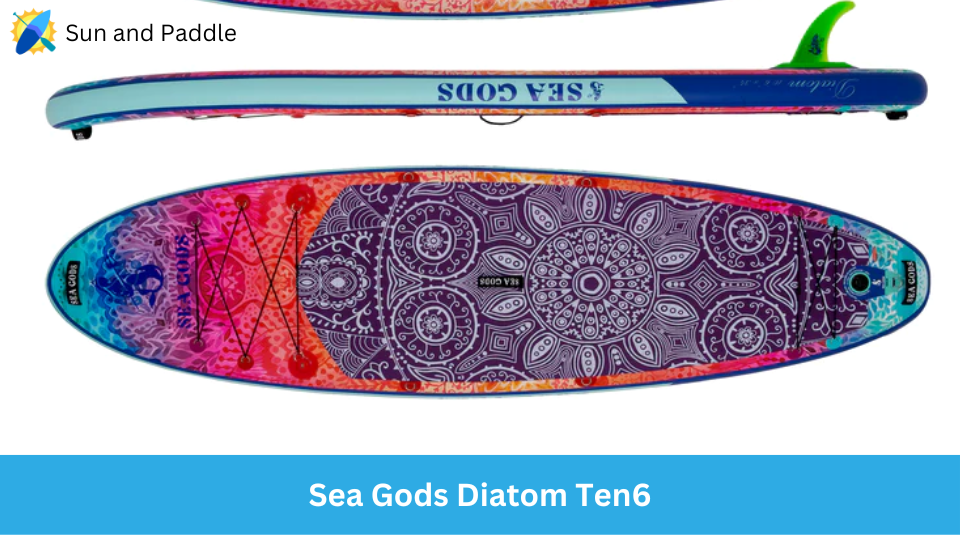
The Sea Gods Diatom Ten6 is an excellent choice for men due to its robust build and stability. Measuring 10’6” in length and 34” in width, it offers a firm platform perfect for yoga poses.
Constructed from military-grade PVC, this inflatable paddleboard is both durable and resistant to punctures. Its non-slip traction pad helps maintain balance and reduce slipping during yoga sessions. Additionally, the Sea Gods Diatom Ten6 includes multiple action mounts for attaching accessories like cameras or water bottles, adding convenience to your practice. Here are the 5 best SUP yoga boards for men: https://sunandpaddle.com/sup/boards/yoga/men/
Best SUP Yoga Paddleboard for Women: Nixy Venice
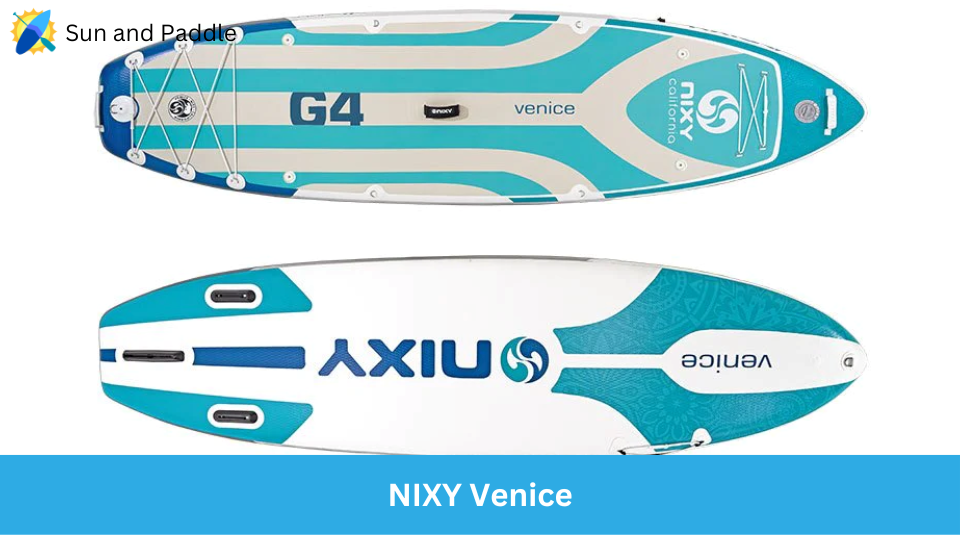
The Nixy Venice is tailored for women, offering a blend of light weight and stability. This paddleboard measures 10’6” in length and 34” in width, providing ample space for various yoga poses.
Its lightweight construction makes it easy to handle both in and out of the water. Made with dual-layer PVC, the Nixy Venice ensures durability and longevity. This board features a softened traction pad for added comfort during long sessions. It also comes with a wheeled backpack, facilitating easy transport. Here are the 5 best SUP yoga boards for women: https://sunandpaddle.com/sup/boards/yoga/women/
Best SUP Yoga Paddleboard for Kids: Bluefin Cruise Jr
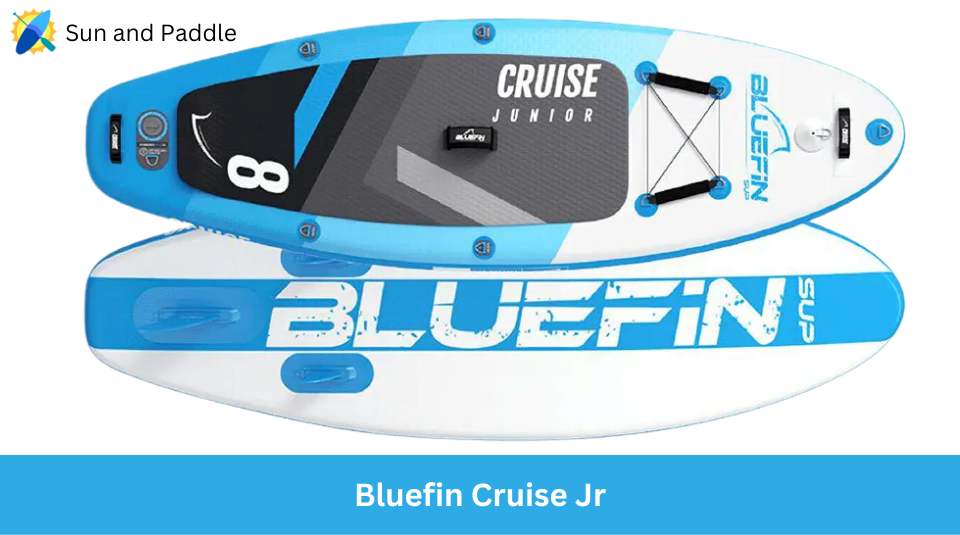
The Bluefin Cruise Jr is perfect for kids. At 8’ in length and 29” in width, it’s sized just right for smaller paddlers.
The board’s smaller size makes it easier for children to control and maneuver. Constructed with military-grade PVC, it’s durable enough to withstand rough use. The Bluefin Cruise Jr includes a kayak seat, allowing kids to switch between kayaking and paddleboarding. Its soft deck pad ensures extra comfort and safety during practice. Here are the 5 best SUP yoga boards for kids: https://sunandpaddle.com/sup/boards/yoga/kids/
Best SUP Yoga Paddleboard for the Bay: iRocker All-Around 11’
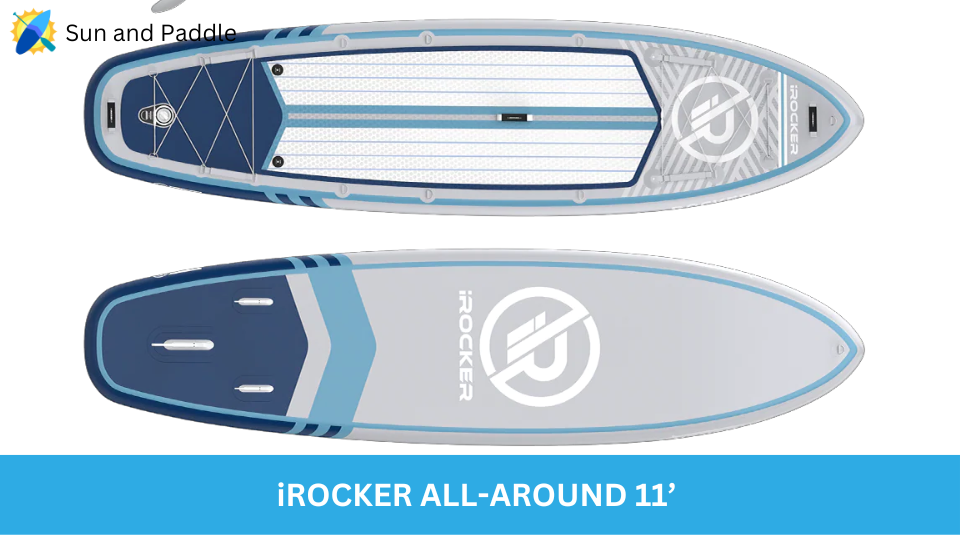
The iRocker All-Around 11’ is ideal for yoga in bay areas. With dimensions of 11’ in length and 32” in width, it provides excellent stability in calm and choppy waters.
Its planing hull design ensures smooth gliding over waves, making it suitable for varied water conditions. Made from triple-layer military-grade PVC, this board is extremely durable. The iRocker All-Around 11’ features multiple action mounts for accessories, adding functionality. It also includes a hand pump and a repair kit for on-the-go fixes. Here are the 5 best SUP yoga boards for the bay: https://sunandpaddle.com/sup/boards/yoga/bay/
Best SUP Yoga Paddleboard for a Lake: iRocker All-Around 11’

The iRocker All-Around 11’ is also perfect for practicing yoga on a lake. Its sturdy build and dimensions provide a stable surface ideal for calm lake conditions.
The board’s traction pad ensures solid grip for yoga poses. With the same triple-layer military-grade PVC construction, durability is assured. This board also includes storage options like bungee cords for securing extra gear. Its portability is enhanced by the wheeled backpack provided. Here are the 5 best SUP yoga boards for the lake: https://sunandpaddle.com/sup/boards/yoga/lake/
Best SUP Yoga Paddleboard for a Pool: Gili 15’ Manta Ray
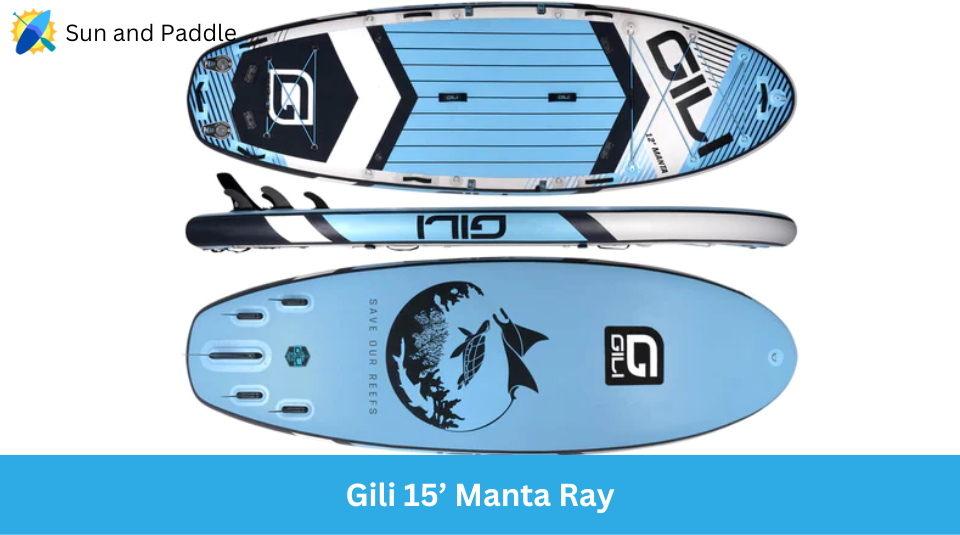
The Gili 15’ Manta Ray stands out as the best SUP yoga paddleboard for a pool. At 15’ in length and 56” in width, it’s extra spacious, accommodating more yoga practitioners at once.
This board’s large size offers exceptional stability, crucial for yoga exercises. Constructed with military-grade PVC, it guarantees durability. The non-slip deck pad provides a safe practice area. Despite its size, it is easy to store and transport with a rolling backpack included. This board also comes with an electric pump, making inflation quick and effortless. Here are the 5 best SUP yoga boards for the pool: https://sunandpaddle.com/sup/boards/yoga/pool/
How Do You Store a SUP Yoga Paddleboard?
There are several methods to protect your board from damage during storage:
With a Rack
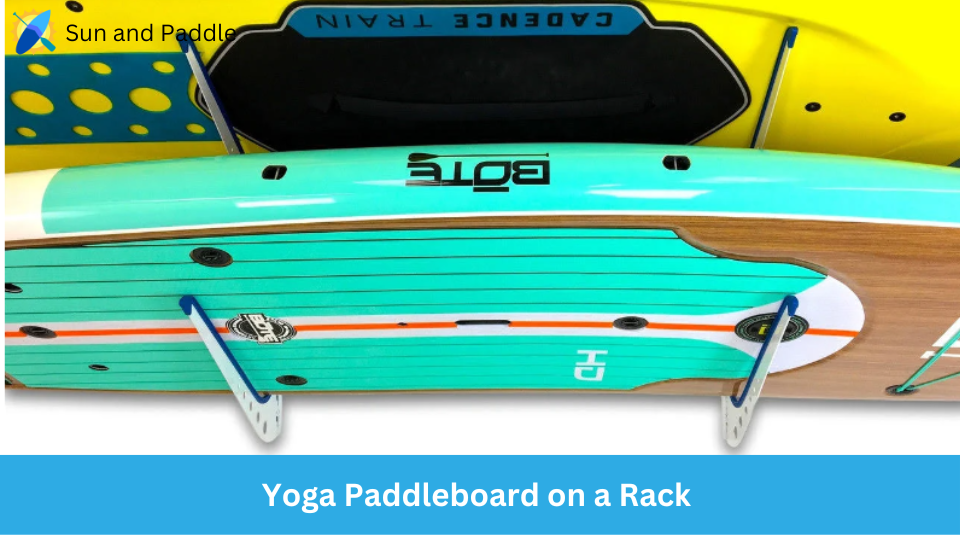
Numerous paddlers utilize racks to maintain their boards. Whether you construct your rack or purchase one explicitly designed for SUPs, it should have padding or straps to protect the board. Some racks support the board on its edge, while others extend across its body. To prevent damage to the hull, rack your SUP with the deck (top) of the board against the rack for the latter design.
Suspended
Hanging your board from the ceiling is an effective method for keeping it out of the way. You can purchase a suspension system designed specifically for stand-up paddleboards or create your own using wide webbing straps. Position your board with the hull facing the ceiling for optimal hull protection.
Leaning
The easiest solution may be to rest the board against the wall. You can accomplish this by placing the SUP on its side or tail (never place a board on its snout). It would help if you placed some padding between the board and the floor to safeguard your SUP. Remember that many SUPs are 10 feet or longer, so you’ll need high ceilings to rest your board on its tail. Additionally, it is prudent to secure the board with a strap or a wooden stake on each side to prevent it from falling unexpectedly.
Leaving an inflatable SUP partially inflated (at approximately 5 pounds per square inch) and storing it as you would a rigid board can prevent persistent creases and deformations. The portability of inflatable SUPs is a significant selling point.
Therefore, if capacity is limited, deflate it entirely and follow these tips:
- Leave the valve uncovered.
- Make sure the board is thoroughly spotless and dry.
- Avoid rigidly compressing the board; loosely rolling it up is preferable.
- Please keep it in a cold, dry location, preferably inside.
How Do You Transport a SUP Yoga Paddleboard?
Transporting a Paddleboard in the Bed of a Pickup Truck
If you have a pickup vehicle, you can place the board deck-side down in the bed with the nose supported by the tailgate. However, the roof is the only option for many individuals with sedans, station wagons, and vehicles.
Transport on the Roof of Your Car
To safely transport a stand-up paddleboard on the roof of your car, you’ll need the following:
A. Crossbars
Your vehicle’s canopy is covered with crossbars. Most crossbars affix to the front-to-rear factory-installed bars on your vehicle, but this depends on your vehicle type. There are even crossbar systems designed for vehicle beds.
B. Rack/padding
There are specific SUP rack systems that affix to the crossbars and make transporting a board straightforward and secure. Alternatively, you can use foam blocks or padding.
C. Cam straps
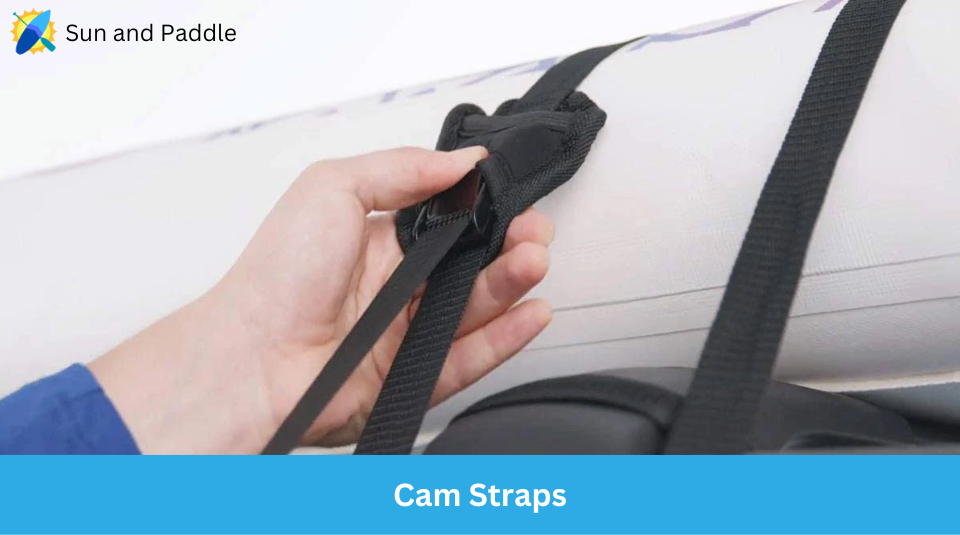
Cam straps fasten your SUP securely to the ground. You will need two straps that are at least 12 feet long.
D. Stern and bow lines
You can use a non-stretch, water-resistant rope, but ratcheting lines make the task much simpler and quicker. One line is required for the bow and another for the rear. With the crossbars and rack/padding installed and the straps/lines nearby, you can load your SUP onto the roof of your vehicle.
Other Tips for Transporting Stand-Up Paddleboards:
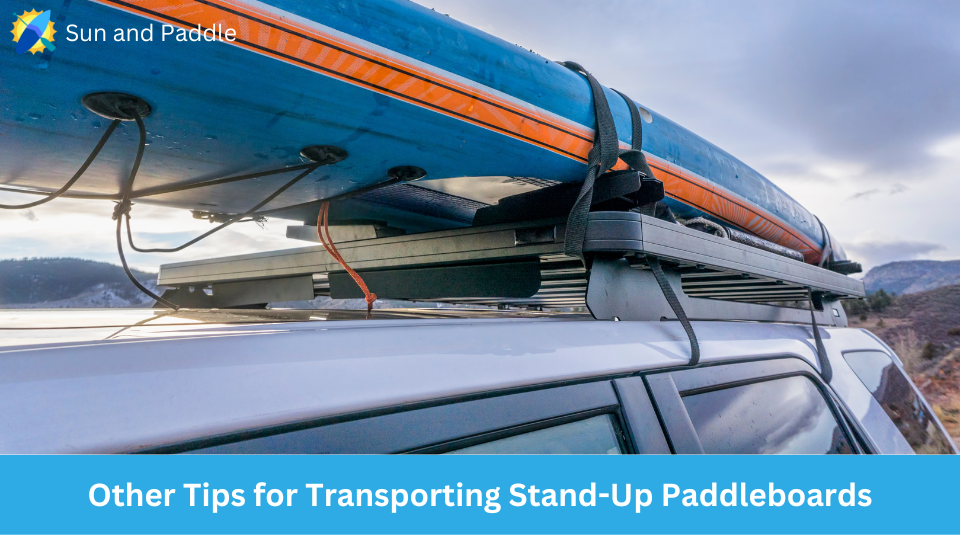
A. Don’t forget your paddle
If it suits you, you can transport your paddle inside your vehicle. Consider a paddle holder that attaches to your roof rack if it does not.
B. Place the longest SUP first
If you intend to place multiple SUPs on your roof, you will orient them in the same direction and arrange them on top of one another. Start by stacking the longer SUP on top of the shorter one. To prevent injury, the SUPs should be padded.
C. Pad your truck’s tailgate
If you store your board in the truck cargo, place some padding on the tailgate to safeguard the board. Also, secure your board in the bed to prevent excessive movement. Red flags should be placed on the nose of longer boards to alert other vehicles.
Frequently Asked Questions
When choosing a paddleboard for SUP Yoga, it’s essential to consider factors like stability, size, and suitability for different skill levels. The right features help in maintaining balance and enhancing the overall yoga experience on the water.
What are the key features to look for in a paddleboard specifically designed for yoga?
A paddleboard designed for yoga should have a wide, stable platform, a non-slip deck pad, and moderate thickness. These features help in performing poses with ease. Additionally, some boards offer attachment points for accessories like anchors or paddle holders.
How does the width of a paddleboard impact yoga practice on the water?
The width of a paddleboard directly impacts its stability. Boards that are 34 to 36 inches wide provide a more stable surface. This width helps in maintaining balance, especially during complex yoga poses. A wider board ensures you can move freely without tipping over.
Can beginners use the same paddleboards as advanced users for SUP Yoga?
Yes, beginners can use the same paddleboards as advanced users, but they may prefer boards with extra width and stability. Advanced users might opt for lighter, more maneuverable boards. It’s essential for beginners to choose boards that offer maximum stability to build confidence.
In terms of stability and balance, how do inflatable paddleboards compare to rigid ones for yoga?
Inflatable paddleboards can offer similar stability and balance as rigid ones when properly inflated. They are also more portable and easier to store. Rigid boards might feel more solid, but inflatables with the right construction can be just as effective for yoga practices.
What size paddleboard is most appropriate for someone new to SUP Yoga?
For beginners, a paddleboard that is 10 to 12 feet long and 34 to 36 inches wide is ideal. This size provides a stable base, making it easier to balance and perform yoga poses. Longer boards offer more surface area, which aids in stability.
How to select a SUP paddle that complements yoga practice?
Choose a SUP paddle that is lightweight and adjustable. This allows for easy transport and customization to different body heights. The paddle should have a comfortable grip and be easy to handle, ensuring it doesn’t interfere with your yoga practice on the water.

